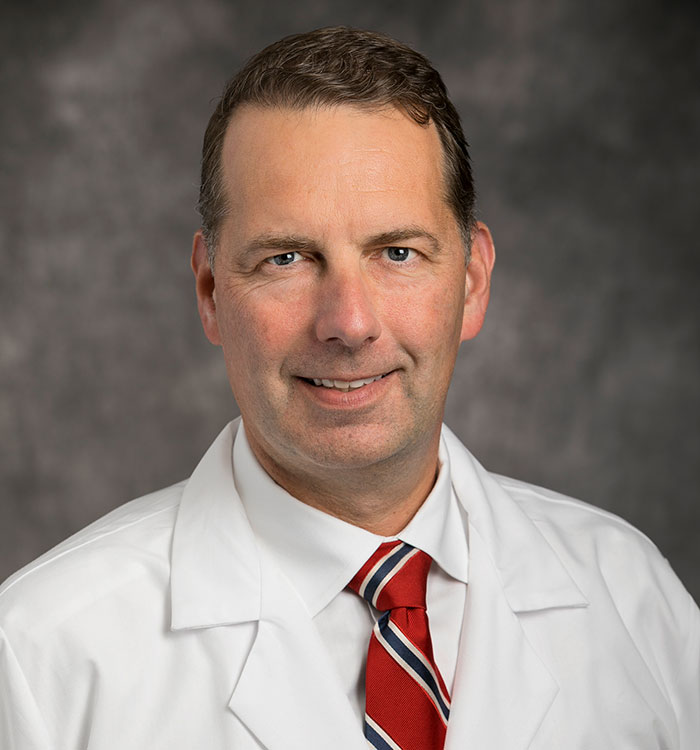University Hospitals’ Mobile ECMO Team Brings Life-saving Care to Gravely Ill COVID-19 Patients Across Northeast Ohio
January 28, 2021
Therapy gives select patients even odds of survival
Innovations in Cardiovascular Medicine & Surgery | Winter 2021
As the COVID-19 pandemic has progressed, a team within the Harrington Heart & Vascular Institute at University Hospitals Cleveland Medical Center has mobilized to provide the most desperately ill COVID-19 patients with access to extracorporeal membrane oxygenation (ECMO) therapy – often deploying with mobile ECMO units to smaller community hospitals that are part of the University Hospitals (UH) system, and even to some that are not.
 Marc Pelletier, MD
Marc Pelletier, MD“The patient might be in a hospital system that's outside of UH, but they don't have ECMO at their hospital,” says Marc Pelletier, MD, Division Chief of Cardiac Surgery at University Hospitals Cleveland Medical Center, and Clinical Professor at Case Western Reserve University School of Medicine. “It is a really good example of how the UH system can work well for all of our smaller community hospitals. If someone is being admitted with COVID-19 to a community hospital and that person deteriorates, they're going to get the same care that somebody is getting at UH Cleveland Medical Center.”
University Hospitals is among just a small number of hospital systems with the expertise necessary to provide this specialized and advanced therapy to its community, Dr. Pelletier says. According to the Extracorporeal Life Support Organization, which tracks the use of ECMO in COVID-19 patients, the therapy has been used just over 4,200 times worldwide since the pandemic begin, with the number of cases in North America just over 2,800.
“ECMO is an evidence-proven technology to support patients with life-threatening respiratory failure that is progressing despite maximal medical therapy,” says Colin McCloskey, MD, a critical care physician at University Hospitals and Assistant Professor of Emergency Medicine at the School of Medicine. “It allows our sickest COVID-19 patients the opportunity of time to improve. We have a great multidisciplinary team in the Cardiovascular Intensive Care Unit that allows us to provide care for these critically ill individuals.”
There is no question that the pandemic has led to unprecedented and extraordinary pressures on health systems worldwide,” adds cardiac surgeon, Yasir Abu-Omar, MD, Surgical Director of Cardiothoracic Transplantation and Mechanical Circulatory Support for UH Harrington Heart & Vascular Institute. “This required us locally as an organization to come together to support the fight against the pandemic and rapidly produce algorithms and guidance measures as well as prepare for potential surges in the number of patients with COVID-19. As a team, we ensured the availability for deploying experienced staff around the clock as well as the expansion of ECMO equipment to cope with such a surge.”
HOW DOES THE COVID-19 ECMO TEAM OPERATE AT UNIVERSITY HOSPITALS?
When a call comes in, the team, made up of an intensivist, a physician from the cardiothoracic ICU and a cardiac surgeon, have a comprehensive discussion of the patient with the referring physician. In some cases, the UH COVID-19 ECMO team may be able to recommend changes that may make ECMO unnecessary, Dr. Pelletier says.
“Out of those calls, a lot of the times our intensivists can give them advice,” he says. “Sometimes with changes to the ventilator or putting the patient in a prone position, your ventilator might work better. So that's what we end up doing.
"When these measures aren’t successful or possible, the team next further evaluates whether the patient is a good candidate for ECMO. The best candidates, Dr. Pelletier says, are relatively young patients who don’t have significant comorbidities.
“If you've been relatively healthy and this is your only chance, then we think that people should be given that chance,” he says.
The UH COVID-19 ECMO team prefers to treat patients at the flagship UH Cleveland Medical Center whenever possible, Dr. Pelletier says. But in some cases, the COVID-19 patient is too gravely ill to risk transport, so the mobile ECMO team is deployed.
“The deployment means that we have our on-call surgeon, our perfusionist and a surgical assistant,” he says. “We gather the devices that we need -- an ECMO cart or an ECMO bag. That’s a large suitcase that has all the materials that are all sterilized that we would need -- the drapes, the gowns, the gloves for the environment that we're going into, but most importantly, the tubing and the machine. It's essentially a heart-lung machine or an ECMO circuit. We hop into an ambulance and we get taken to the patient’s location. We’ll have a briefing with the team that's there managing that patient to make sure nothing has changed. And then we start the process of putting that patient on ECMO. That's usually a 30- to 60 minute process.”
Typically, COVID-19 patients are on ECMO for seven to 14 days, Dr. Pelletier says.
“Then the main issue is whether over the next few days or weeks, the lungs are going to be able to recover enough so that we can take them off ECMO,” he says.
Data from the Extracorporeal Life Support Organization show that ECMO gives these most gravely ill COVID-19 patients about a 50-50 shot at survival.
Even given these odds, Dr. Pelletier says he’s gratified that the ECMO team at UH is able to use its expertise to offer these patients at least some measure of hope.
“When you have a 25- or 30-year-old, young, otherwise healthy patient who is dying, then that at least gives them a chance,” he says. “We have a team that's available 24 hours a day to assess these patients and go put them on ECMO if it's the right thing to do. I think we should be really proud of that because most hospital systems in the U S don't have that capability at all.”


